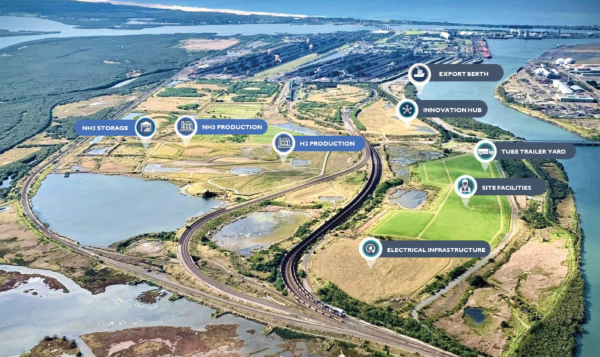The Clean Energy Precinct: Port of Newcastle’s renewable ammonia plans unveiled
By Geofrey Njovu on May 10, 2023

At the Port of Newcastle in New South Wales, Australia, 220 hectares of land will be developed into a production, storage and export hub featuring renewable hydrogen and ammonia. The Clean Energy Precinct is expected to host 1.6 GW of electrolytic hydrogen production within 5 years, creating over 5800 jobs in the process. Recycled water will be used in the electrolysis process.
Newcastle Port already has a deep-water shipping channel and access to global energy export routes – both of which are ideal for an integrated clean energy hub. This is further supplemented by existing grid connections and industrial partnerships with adjacent facilities.
The project aims to leverage economies of scale and competitive pricing by locating hydrogen producers, users and exporters in close proximity. Three visual renders of the project’s first phase have been unveiled, showing the integrated energy hub with proximally located key infrastructure.
Stage 1 of the project would comprise establishment of lead-in infrastructure including electrical infrastructure, water infrastructure and ancillary works, construction vehicle and workforce vehicle parking, construction laydown and stockpiles and construction of a clean energy storage facility.
Symon Byrnes, Project lead and Port of Newcastle Chief Commercial Officer in the port’s official press release, 3 May 2023
“Through the Clean Energy Precinct, Port of Newcastle will support all hydrogen, and clean energy projects in the Hunter by providing land, utilities, storage, transport and export infrastructure and services – in turn generating over 5800 jobs, new educational pathways and expanded economic growth.”
Craig Carmody, Port of Newcastle Chief Executive Officer in the port’s official press release, 3 May 2023
The project is backed at both regional and federal government level and has so far received a $100 million funding commitment from the federal government. Commencement of work in the first phase is slated for 2025, with the project expected to be fully operational in 2028.
Also in Newcastle, last year Orica and Origin announced the nearby ‘Hunter Valley Hydrogen Hub‘ project, a feasibility study into a renewable hydrogen project using recycled water and a grid-connected 55 MW electrolyser. The hydrogen would be used for renewable ammonia production on Kooragang Island.